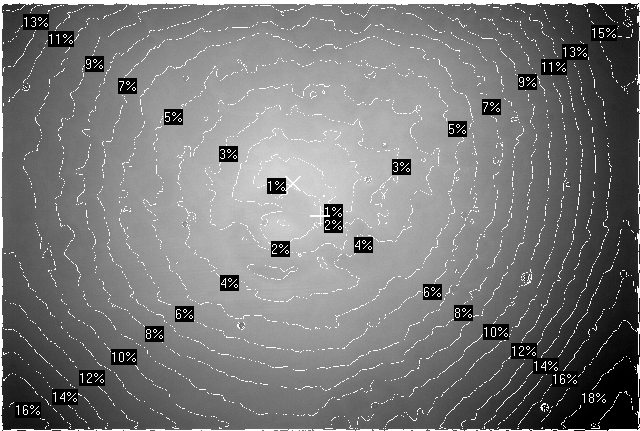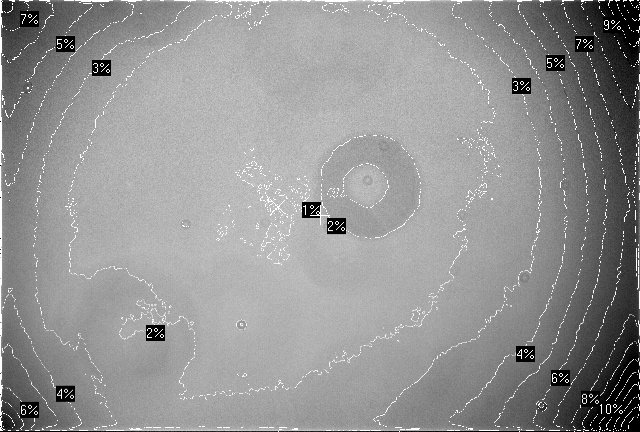David's Astronomy Pages
Notes - Session 411 (2010-01-18)
Notes
(S410)
Notes
Main
Home
Page
Notes
(S413)
David's Astronomy Pages
|
Notes (S410) |
Notes Main |
Home Page |
Notes (S413) |
2010-01-15 to 2010-01-17 Temporary Setup - 8" LX200 Classic & ST-10XME (2010-01-15) Filter Wheel changes (2010-01-15) Focus Offsets (2010-01-17) Filter Flats (2010-01-17) 2010-01-18 Focuser Coefficients, 8" LX200 at f/10.1 (2010-01-18) Polar Alignment Adjustment (2010-01-18) Instrumental Magnitude Comparison (2010-01-18) 
Images from 2010-01-18 >>
My old 8" LX200 Classic scope was brought into back
action for the next few sessions.
This is temporary arrangement whilst my 12" LX200R scope goes in for an
electronic repair
| Optical Train : | F/10 8" LX200 / Optec TCF-S / CFW10 / ST-10XME |
| Expected Values | |
| Expected Focal Ratio : | f/10 |
| Expected Focal length : | 2000mm |
| Expected Image Scale : | 1x1: 0.70 arc sec /px, 2x2: 1.40 arc sec/px, 3x3: 2.1 arc sec/px |
| Actual Values | (determined on 2010-01-17) |
| Actual Focal Ratio : | f/10.1 |
| Actual Focal length : | 2115mm |
| Actual Image Scale : | 1x1: 0.66 arc sec/px, 2x2: 1.32 arc sec/px, 3x3: 1.98 arc sec/px |
Back to Top
As part of setting up imaging equipment on 8" scope, opportunity was taken to undertaken some overdue maintenance and changes to my CFW-10 filter wheel. This comprised
- removal of an annoying dust speck for the middle of camera
window, which has been compromising the quality of images
- cleaning/dusting of filters where necessary
- replacement of Red filter by H-alpha (Baadar, 7nm narrowband Ha) filter
Back to Top
As part of returning to imaging using my backup 8" scope,
focus offsets were determined for each filter relative to the C (Clear) Filter.
This was performed by taking images of a moderately bright star at different
focuser step positions and determining the position of optimal focus from the
resulting focus profile.
It was expected that focus offsets would show a regular correspondence with the
offsets previously generated for 12" LX200 operating at f5.7, but this was
not the case. For some filters which previously had focus positions inside
the C filter with 12" setup where found to be outside the C Filter focus
position with 8" setup. Unless I had been previously carrying an
offset error, it assumed that the difference is related to the different optical
configuration between the two setups (with the 12" setup using an f6.3
focal reducer, whilst the 8" setup did not).
| 12" LX200 at f/5.7 | 8" LX200 at f/10 | |||||
| # | Filter | Filter offset | Filter Offset | |||
| 1 | C | 0 | 0 | |||
| 2 | B | 74 | -190 | |||
| 3 | V | -48 | -30 | |||
| 4 | R | -113 | 15 | |||
| 5 | I | 166 | 165 | |||
| 6 | Red | -2012 | ||||
| Ha | -380 | |||||
| 7 | Green | -2132 | -560 | |||
| 8 | Blue | -2133 | -750 | |||
| 9 | S | -1881 | -425 | |||
| 10 | U | 337 | -470 |
Notes:
1) S Filter (#9) = Star Analyser 100
2) Both setups used exactly the same camera to filter wheel
distance.
|
Example Focus Profile - C Filter (2010-01-17) |
|
|
Width of the profile at 10 arc secs FWHM is around 1080 steps (average) +/- 60 steps
| Setup | Profile width | Theoretical | ||
| at 10 arc sec FWHM | CFZ | |||
| 8" LX200 at f/7.4 | 1972 steps | 56 steps | ||
| 12" LX200 at f/5.7 | 1890 steps | 103 steps | ||
| 8" LX200 at f/10 | 1080 steps | 33 steps |
Theoretical CFZ (Critical Focus Zone)
= (focal ratio)^2 * 2.2 (in microns)
Step size for Optec TCF-S focuser = 0.000085" (or 0.00216mm, or
2.16 microns)
Back to Top
As part of setting up imaging equipment on 8" scope, new flat frames were taken for each filter after focus position details had been set.
| Flat Analysis Map for 8" LX200 setup f/10.1 (CCD Inspector) |

|
|
Master Flat Frame 17 x 5s exposure (average median combine), 1x1 binning, C Filter 2010-01-17, 8" LX200 Classic (at f/10.1) + ST-10XME |
| Earlier Flat Analysis Map for 12" LX200 setup f/5.7 (CCD Inspector) |

|
|
Master Flat Frame 15 x 1s exposure (average median combine), 1x1 binning, C Filter 2009-03-26, 12" LX200R (at f/5.7) + ST-10XME |
Back to Top
Focus positions for the C Filter were collected over a 6 degC
temperature range during the two observatory sessions on 2010-01-17 (+2 to +3
degC) and 2010-01-18 (0 to -3 deg C)
The dataset is plotted below. Best fit line indicates
The dataset is rather ambiguous and there appears to be a
focus shift at around -1 degC. This might be due to a mirror shift (no mirror
lock on 8" LX200 classic), uneven cooling of the telescope during the
second session or atmospheric changes. Until more data is collected the
range in temperature coefficient is rather wide (-95 to -150 steps per degC).
|
Temperature Coefficient Plot (2010-01-18) - 8" LX200 operating at f/10.1 |
|
|
|
Earlier Temperature Coefficient Plot (2008-09-22) - 8" LX200 operating at f/7.4 |
|
|
Back to Top
Although the 8" LX200 was mounted onto a wedge that was already well aligned to celestial north pole axis, it was quickly clear that some adjustment to the wedge was required.
Slewed to South Sky Point / Measured Star drift
Time Interval : 5.13 mins
Baseline Az : 176.1 degrees
Declination Drift : 0.07 arc secs/min SOUTHWARDS
Polar misalignment : 0.27 arc mins (approx)
** Star drift is very small and wedge mount is pointing more or less
northwards ok.
Slewed to West Sky Point / Measured Star Drift
Time Interval :
5.12 mins
Baseline Az : 271.8 degrees
Declination Drift : 3.47 arc secs/min SOUTHWARDS
Polar misalignment : 13.24 arc mins (approx)
Y Star
change 397.4 --> 383.9 (confirm
star drifts southwards)
** Star drifts south and
therefore scope's axis points above the pole and needs to be lowered
Polar Axis Correction (altitude)
1) Slewed to South Sky Point
2) Centre a bright star
3) Jog south by 13.25 arc mins
4) Use wedge adjustments to recentre star
Although the correct step would be to jog south by 13.25 arc mins (rounded
from 13.24) , the actual step made was a jog north by 13.25 arc mins,
which had the negative result of increasing the polar axis error to ~ 26.5 arc
mins, instead of reducing it to ~ 0 arc mins.
Slewed to South Sky Point / Re-Measured Star Drift
Time Interval : 5.12 mins
Baseline Az : 185.0 degrees
Declination Drift : 0.84 arc secs/min SOUTHWARDS
Polar misalignment : 3.21 arc mins (approx)
** Star drifts south now even
though no change to wedge azimuth has been made since earlier measurement
(is this because the Polar Axis elevation is now out by over 25 or
26 arc mins ?
** In theory the southward drift implies that the scope's polar axis is
pointing too far east and needs turning anti-clockwise
Slewed to West Sky Point / Re-Measured Star Drift
Time Interval : 5.12 mins
Baseline Az : 271.6 degrees
Declination Drift : 6.61 arc secs/min SOUTHWARDS
Polar misalignment : 25.24 arc mins (approx)
Y Star
change 465.6 -- > 439.9
(confirms star drifts in southwards)
** Star drifts south and therefore scope's axis points above the pole and needs to be lowered by 25.24 arc mins
Polar Axis Correction (altitude)
1) Slewed to South Sky Point
2) Centre a bright star
3) Jog south by 25.25 arc mins
4) Use wedge adjustments to recentre star
Although a jog south of 25 arc min was commanded, the actual jog change made was
22.78 arc min (southwards). A second southward jog of 2.2 arc min was commanded,
after which the net actual jog was measured to be 23.74 arc min (southwards). A
third southward jog of 1.8 arc min was then commanded, after which the net
actual jog was measured to be 25.65 arc min (southward). This was taken as being
sufficiently
close to the 25.25 arc min required,
Star was then re-centred using wedge altitude controls, since stars needs to be moved southward (ie upwards for 180 deg rotated realtime image) the adjustment process involved turned the altitude control knob clockwise (loosening the wedge and moving the bright reference star back to the CCD field centre), with then a final anticlockwise adjustment to take out the slack and firm up the control knob tension.
Ideally South Sky and West Sky points would again be measured at this point, however imaging was begun directly without making a further check.
Back to Top
Comparisons between Instrumental Magnitudes with different setups
| Star | Filter | 8" LX200 at f/7.3 ST-7E |
8" LX200 at f/10.1 + ST-10XME |
12" LX200 at f/7.7 + ST-10XME |
||||
| C Star for SS Cyg | V | -11.8 (30s) | -11.8 ( 5s) | -12.3 (3s) / -13.2 (5s) | ||||
| B | -11.3 (60s) | -11.4 (15s) | -12.0 (10s) | |||||
| R | -12.9 (30s) | -12.0 ( 3s) | -12.1 (1s) / -13.6 (3s) | |||||
| C Star for Z And | V | -11.4 (30s) | -11.9 (10s) | -13.5 (10s) | ||||
| C Star for RR Tau | V | -11.2 (60s) | -11.5 (20s) | -12.3 (10s) | ||||
| C Star for GK Per | V | -12.6 (90s) | -12.7 (20s) | -13.4 (10s) |
Back to Top
| This Web Page: | Notes - Session 411 (2010-01-18) |
| Last Updated : | 2015-05-15 |
| Site Owner : | David Richards |
| Home Page : | David's Astronomy Web Site |